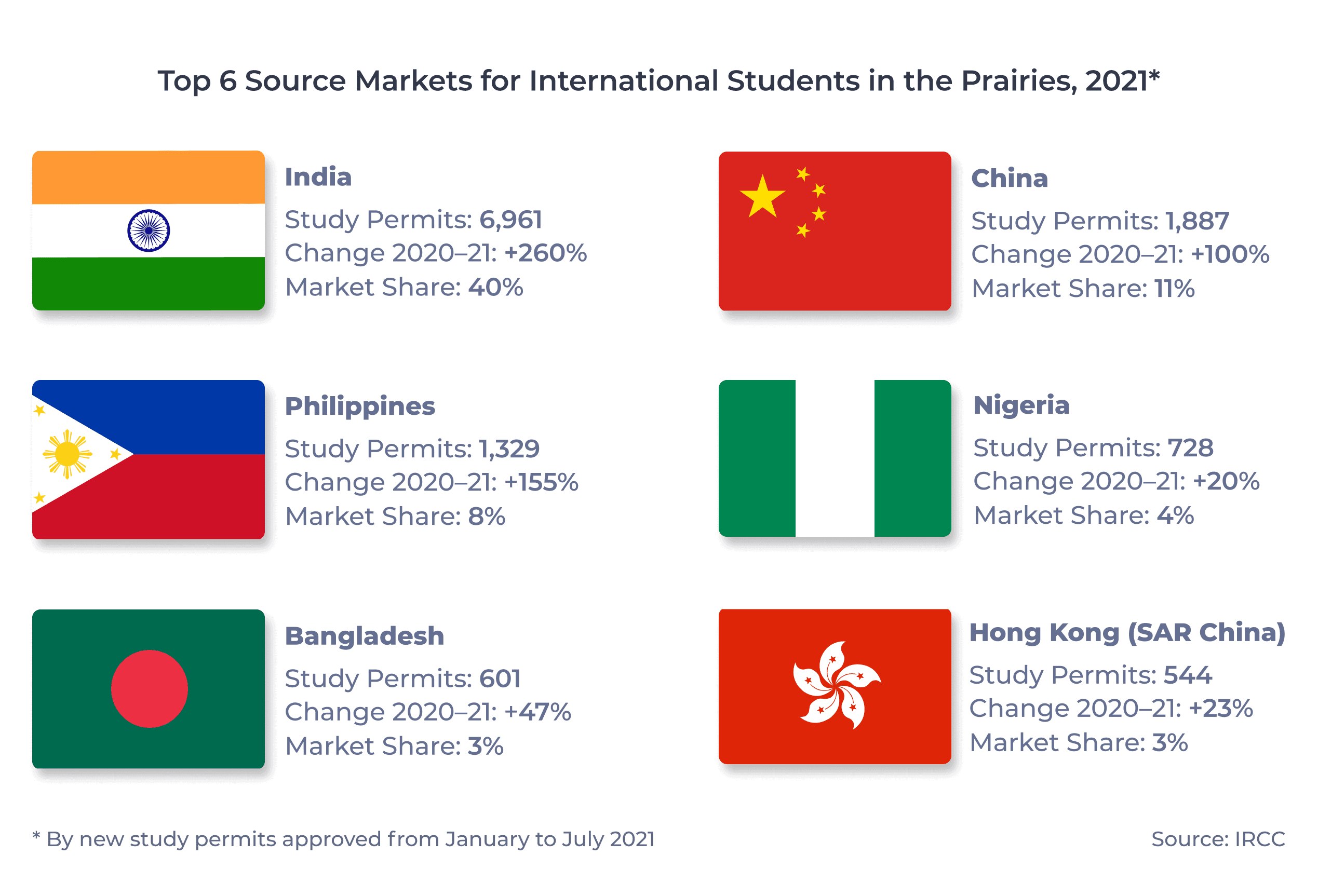Strong college and polytechnic offerings—coupled with vibrant, established international communities—have led to sustained growth in international student interest across Canada’s Prairie provinces. From 2016 to 2018, the number of student visa1 approvals for Alberta, Saskatchewan, and Manitoba grew by nearly 50%. And while that growth tapered off in 2019, the region has come roaring back in 2021.
Key Insights at a Glance
- We estimate that more than 25,000 study permits were issued for Prairie province institutions in 2021, the region’s highest total ever.
- Alberta, Saskatchewan, and Manitoba saw an 84% increase in study permit approvals from January to July 2021 over full-year 2020. That was 8 percentage points higher than the rest of Canada.
- Alberta ranked #2 among all provinces for college study permit approvals between January and July 2021.
- From January to July 2021, one in every three study permits approved in the Prairies was at the college level.
What unique study permit trends are we seeing for Prairie institutions? What are the top source countries feeding schools in Alberta, Saskatchewan, and Manitoba? And how does the Prairies’ rebound compare to the rest of Canada’s? Learn the answers to these questions in our fourth article exploring the Canadian international education market by province.2
Canadian Study Permits Approved – Alberta, Saskatchewan, and Manitoba
From 2016 to 2018, new study permit approvals across Alberta, Saskatchewan, and Manitoba grew by an average of 22% each year. Throughout the rest of Canada, this growth rate was 19%. But in 2019, growth in the Prairie provinces slowed to a crawl. Study permit approvals across the Prairies increased by just 2.5%, while the rest of the country saw a 14% increase.
When the pandemic hit, it was difficult to say which data point was the outlier. But after study permit approvals in the Prairies dropped by 58% in 2020 due to the pandemic, incoming student numbers across the region bounced back big in 2021.3
The chart below shows study permit approvals for Alberta, Saskatchewan, and Manitoba institutions since 2016:
Nearly 22,000 study permits were approved in the Prairies in 2019, driving a record-high year for the region. With well over 17,000 study permits approved between January and July 2021, we project that Alberta, Saskatchewan, and Manitoba comfortably broke that record last year.
Alberta, Saskatchewan, and Manitoba vs. the Rest of Canada
The chart below shows how the Prairie provinces compare to the rest of Canada for new study permits approved since 2019:
| 2019 | 2020 | 2021 (Jan–Jul) | ||
|---|---|---|---|---|
| Prairies | Total | 21,911 | 9,467 | 17,434 |
| YOY Change | +2.5% | -57% | +84 | |
| Rest of Canada | Total | 234,232 | 102,893 | 181,291 |
| YOY Change | +13% | -56% | +76% |
Source: IRCC
The Prairies were not immune to the impacts of COVID-19. But they also weren’t hit any harder than the other provinces, as they experienced an almost identical drop in study permit approvals compared to the rest of Canada in 2020.
While the rest of Canada also came back strong in 2021, the Prairie provinces did even better. With 84% more study permit approvals from January to July 2021 than full-year 2020, Alberta, Saskatchewan, and Manitoba outperformed the rest of Canada by 8 percentage points.
With over 7,000 additional study permit approvals expected to pour into the region before year’s end,4 the big question remains: What’s driving this rapid comeback?
Study Permits Approved by Study Level – Alberta, Saskatchewan, and Manitoba
The source of the Prairies’ climb back to pre-pandemic levels is clear when we examine the number of study permits approved at each study level so far this year:
College is the key driver of growth in these provinces. Study permits approvals at the college level reached an all-time high last year, increasing by nearly 200% from January to July 2021 over full-year 2020. International students are also keen to return to university in the Prairies, as approvals increased by 72% at this level.
Let’s dig into the popularity of study levels among each province in this region. The interactive graph below breaks down the percentage of study permit approvals allocated between study levels. You can toggle between Alberta, Saskatchewan, and Manitoba to see which study levels are popular in each province:

In fact, Alberta experienced the second-highest year-over-year growth in college study permit approvals of any province over the first seven months of 2021, behind only Ontario. This surge in international interest in Alberta colleges is likely a product of the unique program offerings and the competitive—and in some cases refundable—tuition at several Alberta institutions.
We’re seeing a huge push from international students who want to pursue polytechnic degrees, an area that several Alberta colleges have entered. These colleges typically offer a variety of industrial arts, applied sciences, or technical programs and provide a balance of hands-on work experience and academic theory.
Compared to Alberta, international students pursue university studies in Saskatchewan at a much higher rate. 47% of study permit approvals granted to students in Saskatchewan between January and July 2021 were at the university level.
Saskatchewan has also seen encouraging growth at the college level, where the number of study permit approvals tripled, soaring from 241 in 2020 to 814 from January to July 2021.
Saskatchewan’s biggest opportunity for growth lies within the college sector, but institutions need to be strategic. We were pleased to see Great Plains College, Parkland College, and Cumberland College begin a pilot project to recruit and admit international students together. By marketing themselves collectively as “Saskatchewan Colleges,” these schools have recognized both that there is a pressing need to build brand awareness of Saskatchewan as a province and that by pooling resources, they can have an outsized marketing impact.
Like Saskatchewan, Manitoba is a university-focused market. Led by the University of Manitoba, Manitoba universities drive a strong plurality of interest from international students in the province, accounting for over 45% of study permit approvals in Manitoba in each of the past five years.
One of the main draws for students pursuing a university education in Manitoba is the specializations its institutions offer. Agriculture studies is a niche area that several Manitoba universities specialize in and that attracts a large number of international applicants each year.
The market share held by college study permit approvals in Manitoba was up 7 percentage points in the first seven months of 2021 over full-year 2020. This growth is also likely tied to the polytechnic boom in the Prairie region.
Study Level Comparison: Alberta, Saskatchewan, and Manitoba vs. Rest of Canada
Let’s see how the popularity of universities in the Prairies compares to the popularity of universities in the rest of the country:
Nearly one in every two study permits approved outside of the Prairies in 2021 was for a college program. The landscape is much different in Alberta, Saskatchewan, and Manitoba, where university is the dominant choice of international students. But there’s a catch.
As we’ve previously touched on in this series, Ontario’s large number of high-capacity colleges tips the scales on the “rest of Canada” data.5 The aggregate rates of study permit approvals for K-12 and language studies for the Prairie provinces are largely in line with all other provinces not named Ontario,6 while the Prairies actually lag slightly behind the other non-Ontario provinces in university market share (43% to 46%) and lead in college (33% to 24%).
This strong college sector performance to date is an indication that we could expect steady growth of international enrollment among Prairie colleges in the near future.
Top Source Countries for Prairies Students
While the pandemic had a significant impact on how many international students attended Prairie institutions in 2020 and 2021, we saw little change in where those students come from: 
Study permit approvals to Hong Kong students have grown by 340% in the Prairies since 2016. We can trace this growth to Hong Kong students and their families looking to relocate to a country with a more stable political climate. Look for this number to continue to grow as more Hong Kong-based communities take root throughout Alberta, Saskatchewan, and Manitoba.
In late 2020, the Canadian government introduced a number of immigration measures to support Hong Kong residents, including a program which supports priority visa processing for Hong Kong youth and facilitates family reunification.
Aside from Hong Kong, Peru (+173%), Ecuador (+125%), Iran (+108%), Chile (+106%), and Germany (+93%) were among the top emerging markets for Prairie province institutions, based on study permit approval growth since 2016.
Looking Forward
The Prairies have earned a seat at the table among the most desirable study abroad regions in Canada. Students are expressing a clear desire to learn in Alberta, Saskatchewan, and Manitoba, especially at the post-secondary level.
Growth patterns from the first seven months of 2021 point towards plenty of reasons to be optimistic about the future of this region and the many educational opportunities it provides. We’ll provide an update on these markets once full-year data comes in.
Here are our thoughts on what institutions in the Prairies can do to continue the rebound we’re seeing:
- Share with prospective students clear linkages with industry, employment options, and median salaries of graduates to drive home the opportunity for international students to build careers and put down roots in the Prairies.
- Offer flexibility with transfer credits, such as 2+2 collaborative programs between colleges and polytechnics or colleges and universities, to present a clear path for international students to pursue the career they desire.
- When recruiting, update school websites with interactive and high-quality tours of facilities, such as labs and study spaces.7
- Continue to collaborate with each other to promote the province first, and lean on organizations such as the Manitoba Council for International Education (MCIE) to stay consistent with provincial goals.
Published: January 7, 2022
Subscribe to ApplyInsights
Sign up for the latest insights on international education.

About the ApplyInsights Team
FOOTNOTES:
1. The terms student visa and study permit are generally used interchangeably for Canadian international students. Rather than student visas, Canada provides accepted international students with study permits, which allow those students to enroll in classes at Canadian institutions. When a student is accepted for a study permit, they are also usually provided with a visitor visa, which allows that student to enter Canada for their studies. Study permit data in this article includes new study permits and study permit extensions, unless otherwise noted. Historical study permit statistics used in this article are courtesy of Immigration, Refugees and Citizenship Canada (IRCC), except where noted.
2. Previously, we covered study permit trends in Ontario, Quebec, and Atlantic Canada.
3. Data through July 2021 only.
4. ApplyBoard internal projection based on historical data.
5. You can see what the data looks like with Ontario removed by selecting the option “Rest of Ontario (ON Removed) in the above chart.
6. The Other Studies sector is an exception, with 3% market share in the Prairies versus 7% among the rest of Canada (excluding Ontario).
7. Bow Valley College’s virtual tour is a favourite of ours!



